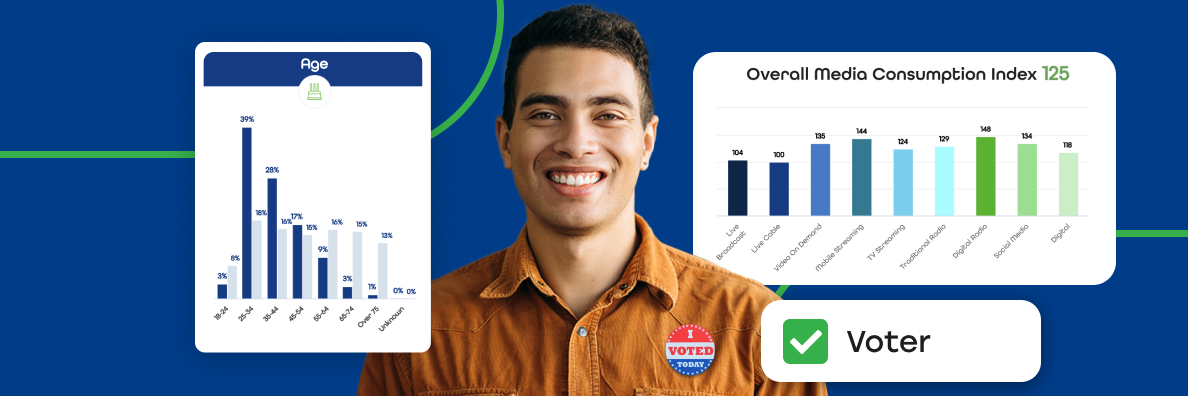Tunnl | Products | Audiences | Platform
The Hispanic vote could decide the election. Both political parties should invest more in Spanish-language advertising.

As campaigns work to connect with a relatively small group of uncommitted voters, they disproportionately target much of their advertising, and spending, to what amounts to less than 20% of voters in any given state. With this focus, it’s typical for campaign strategists to consider broadcast budgets first, with major networks getting large viewership and the most eyes on their ads. Three competing tensions at play with this strategy should make campaigns reconsider their final spending as November approaches.
First, your campaign is fighting for a shrinking pool of ad inventory. Second, the ad inventory is increasingly expensive as you get closer to the Election and groups grab for those final spots. And most importantly, your voter audience isn’t seeing your ads at an equal rate. With a small number of sought after voters seeing a campaign’s ad dozens of times while others are seeing it three times, or not seeing it at all, the case can be made for a longer-tail of ad spending to increase your campaign’s reach to critical uncommitted voters.
Shifting dollars to other mediums could make the difference between winning and losing.
As strategists look at the makeup of their winning coalitions, an often under-represented group in campaign budgets are Hispanic voters, and particularly, Spanish-speaking voters. This is true for both parties, but especially Republicans. Past election exit polling quantifies some of the challenges Republicans have faced in securing support from the Hispanic community. From McCain to Trump, Republicans have trailed in the Hispanic vote by an average of 37 points, peaking at 44 points during the 2012 election. This wasn’t always the case.
Ask the average voter who first launched a Spanish-language ad during a presidential primary, and they'd likely guess Presidents Obama or Clinton. They’d be surprised to learn it was my former boss, George W. Bush who, as a native-Texan, was not afraid to pull out his acquired Spanish for speeches or for ads to reach voters, even if he wasn’t fully fluent. Hispanic voters awarded President Bush for his efforts, giving him 44% of their vote in 2004. That was back when the Hispanic population made up about 13% of our communities.
Much has changed over the last twenty years, and to be sure the parties and the way campaigns are financed and operated are very different. But now, nearly 1 in 5 of our neighbors identify as Hispanic, and their partisan preferences are not monolithic. These are changes Republican candidates, and Democrats, should be taking more into consideration as they wage their final persuasion campaigns. Recent data shows young Hispanic males supporting Republicans at nearly double the rate of their female counterparts. And, earlier this summer, when former President Donald Trump had a slight lead over President Biden, polling showed the former President only down by 7 points with Hispanic voters. While this support is unprecedented for a Republican, we are in the middle of an incredible realignment in American politics. Trump stands to benefit with non-college-educated voters of color, who once wouldn’t have considered voting Republican.
Phoenix, Arizona, highlights the vulnerability both campaigns face in reaching this critical audience. During the month of August in the Phoenix market, advertising data from the Tunnl platform shows presidential campaign focused ads were aired on TV around 20,000 times between the two campaigns. The amount that was shown on Spanish-language TV: less than 1000 ads. September numbers aren’t showing much of a difference. More than 10,000 ads have aired this month and just over 554 hit Spanish-language TV.
For reference, Phoenix is considered one of the largest cities in the U.S. with a plurality Hispanic population — they’re approaching half the area being Hispanic (43%) — and yet, only 4-5% of the presidential-level advertising was on Spanish-language TV.
With the previous election results in Arizona showing a 10,457 vote difference between Biden and Trump in deciding the state, this should be a major wakeup call for both campaigns.
Because of the work Tunnl does in the audience intelligence and strategic media planning space, my team and I have had the opportunity to partner with broadcast groups, buying agencies, and brands, including TelevisaUnivision, to get a better understanding of Hispanic TV audiences, and Hispanic voters, more broadly. While recent polling shows Harris potentially reclaiming the ground lost by Biden, other polling reveals this group to be a more persuadable audience. August polling from TelevisaUnivision in key battleground states show that Spanish-speaking Hispanic voters are the most uncertain of their vote. Put another way, this group is still technically “up-for-grabs.” In Arizona, 35% are not fully certain, North Carolina, 44%, and in Texas, 32%. That makes an immediate case for a push on Spanish-language advertising, on traditional TV, streaming platforms, and across the digital ecosystem.
Ultimately, each campaign needs to make their case to voters in a way that will resonate. And language is a relevant way to connect to culture and to emotion. It’s why I still look up when I hear someone order a “pop” from a table nearby - I am still an Iowan at heart. Voters are more likely to feel campaigns care about them when candidates communicate with them in culturally relevant ways. In many Hispanic households, different generations may have varying levels of Spanish fluency. According to Nielsen, 83% of Hispanic TV households speak some level of Spanish in the home. Placing Spanish-language media isn’t just about reaching individuals who speak Spanish at home. Setting aside the numbers on levels of acculturation in place of a strategy that focuses on building credibility and trust with this increasingly large audience of voters will be paramount to any political campaign, and even any party’s, future.
The gap Bush closed with Hispanic voters in the 2004 election was down to just 9 points against Kerry, the most success a Republican has seen nationally with the Hispanic voter bloc in this modern era. This is a clear lesson the Trump campaign, and other Republicans, could learn from, and a reminder to Democratic campaigns that consistent effort and engagement with persuadable audiences are essential to long-term success.

